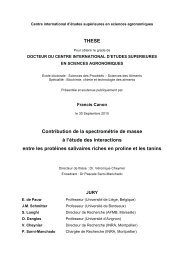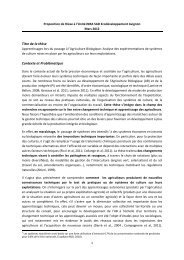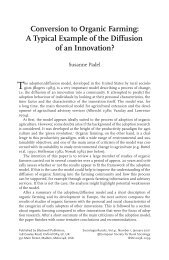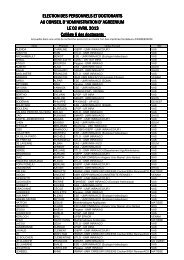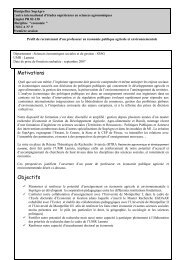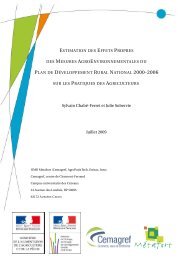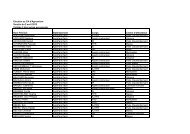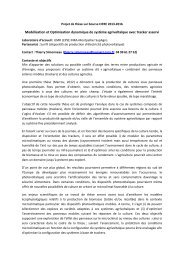Rice (Oryza sativa. L) genetic diversity for early vigor and drought ...
Rice (Oryza sativa. L) genetic diversity for early vigor and drought ...
Rice (Oryza sativa. L) genetic diversity for early vigor and drought ...
- No tags were found...
Create successful ePaper yourself
Turn your PDF publications into a flip-book with our unique Google optimized e-Paper software.
Introductionestimation. The identification of relevant process based traits <strong>for</strong> <strong>genetic</strong> studies was thus a majorchallenge during the last decades <strong>for</strong> ecophysiologists (Dingkuhn et al. 2006; Tardieu et al. 2010).Recently some approaches proved their relevance <strong>for</strong> phenotyping process based traits on a largenumber of genotypes. This is the case of high throughput imaging methods that enable a rapidcharacterization of plant growth dynamics or water status (Berger et al. 2010). The application ofmodeling also showed its relevance to phenotype process based traits using the parameters ofequations <strong>for</strong>malizing plant response to environmental variables to differentiate genotypes; suchparameters are thus genotypic <strong>and</strong> less prone to GxE than corresponding measured variables(Dingkuhn et al. 2006; Tardieu et al. 2010). This was pioneered by Reymond et al. (2004) using asimple model (with 3 equations) predicting maize leaf expansion rate (LER) response toenvironmental variables related to <strong>drought</strong> conditions (leaf temperature, vapor pressure deficit <strong>and</strong>soil water potential). Indeed consistent associations of Quantitative Trait Loci (QTL) <strong>and</strong> modelparameters were reported <strong>for</strong> hundreds of genotypes in maize populations with different <strong>genetic</strong>backgrounds <strong>and</strong> across environments (Welcker et al. 2011).The interest of metabolomics <strong>for</strong> plant phenotyping has been less explored (Fernie et al. 2009),although they might reveal genotypic variation <strong>for</strong> growth <strong>and</strong> adaptation strategies (Stitt et al. 2010)or <strong>for</strong> physiological traits (Ishimaru et al. 2007). The role of non structural carbohydrates (NSC) asmarkers of genotypic growth pattern was demonstrated: on Arabidopsis, Sulpice et al. (2009)reported a negative correlation between seedling growth <strong>and</strong> starch accumulation <strong>and</strong> on Medicagotrucatula V<strong>and</strong>ecasteele et al. (2011) reported a negative correlation between seedling <strong>vigor</strong> <strong>and</strong>sucrose:rafinose ratio. Meanwhile in a preliminary study on 200 rice <strong>sativa</strong> genotypes grown underwell watered conditions Luquet et al. (2008b) reported that <strong>early</strong> <strong>vigor</strong> was associated to low NSCconcentration in the plant. Metabolic component traits demonstrated also their interest todiscriminate genotypes <strong>for</strong> <strong>drought</strong> response mechanisms (Shao et al. 2009; Verslues et al. 2011),rice vegetative growth (Cabuslay et al. 2002). This suggests the relevance of exploring the <strong>genetic</strong><strong>diversity</strong> <strong>for</strong> NSC during rice vegetative growth.OBJECTIVES, OVERVIEW OF THE CHAPTERS AND THE METHODOLOGYWithin Genphen <strong>and</strong> Orytage projects, extensive phenotypic data sets were generated with athreefold purpose (i) identify traits contributing to rice growth <strong>and</strong> adaptation strategies (to <strong>drought</strong>in particular) <strong>and</strong> their <strong>diversity</strong>, (ii) characterize physiological <strong>and</strong>/or <strong>genetic</strong> linkages among traits,<strong>and</strong> their GxE; <strong>and</strong> (iii) detect QTLs <strong>and</strong> related favorable alleles <strong>for</strong> studied traits using a chip ofabout 1 million SNP markers <strong>for</strong> association <strong>genetic</strong>s studies. Genetic studies are planned <strong>for</strong> June2012 when the chip of SNPs markers will be available.17



